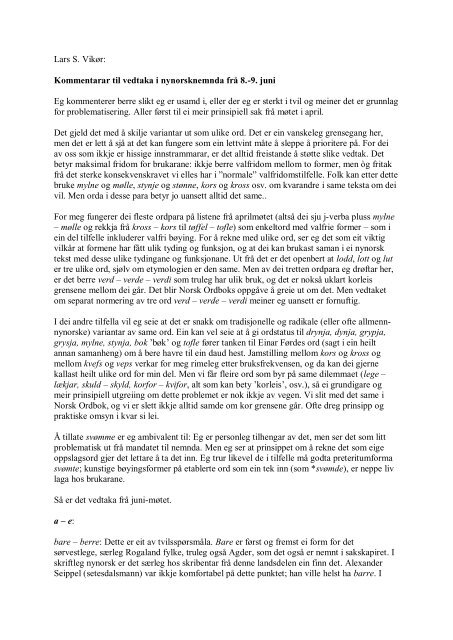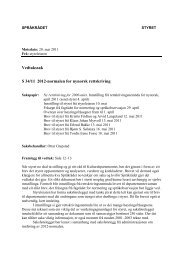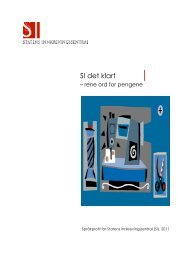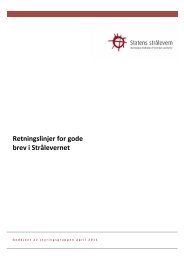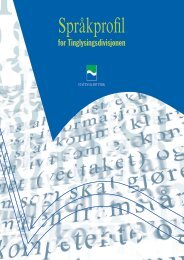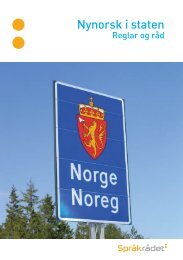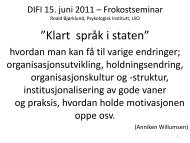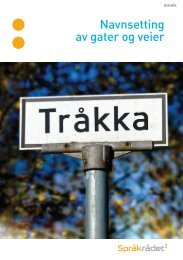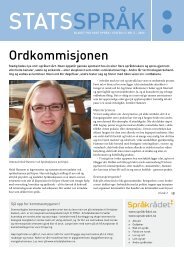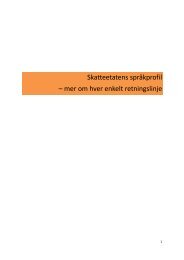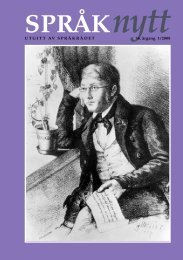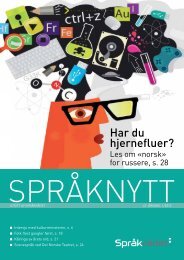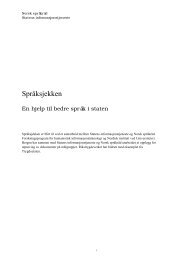Lars S
Lars S
Lars S
You also want an ePaper? Increase the reach of your titles
YUMPU automatically turns print PDFs into web optimized ePapers that Google loves.
International Journal of Engineering and Technology (IJET) – Volume 2 No. 1, January, 2012effects inter-technology handover, while MIH servicesassist in handover initiation. The UE queries the MIHinformation service (without active scanning) which canreside in either the source or target network, and thenproceeds to authenticate and associate with the targetnetwork over the source network. A command service isissued by the MIHF to activate the required interface whenVHO is about to occur.2) Multi-Mode ApproachA multi-mode mobile node can also achieve interfacingWLAN and WiMAX technologies and a gateway functionas described in [9]. The gateway function is typicallyimplemented on an access service network (ASN), whichhandles session management, mobility management,authentication, QoS, and a common authentication,authorization, and accounting (AAA) platform.Interworking between both networks is further simplified,by deploying them using IETF protocols. This gatewayapproach can be adapted for various internetworkingscenarios (UMTS and CDMA 2000, WLAN and UMTSetc.). It is the simplest approach to internetworking andinteroperating dissimilar access networks with little or nomodification to the corresponding radio access networks.This approach however, would require that subscriberinformation be managed by three different entities i.e.additional interfaces from the participating Home LocatorRegister (HLR)/Home Subscriber Server (HSS)/AAA tothe gateway system [10].3) Mobile SIP ApproachThe Mobile-SIP approach is proposed in [11] to achieveWLAN–WiMAX vertical handover. As against the typicalre-Invite method adopted in most of the SIP enabledhandover scenarios, the authors propose a modified midcallSIP method that employs the use of a SIP requestwhen the mobile network changes access networks.Existing SIP re-Invite method requires the correspondingnode to perform the handover by establishing a newmultimedia session using the old connection identifiersand new IP address of the mobile node originating thesession. The authors in [11] anticipate a problem with thismethod, since there is a possibility for the correspondingnode to lose the address of the mobile node. To resolvethis, the corresponding node has to contact the SIP serverin the home network of the mobile node to obtain detailsof its originating session node. For this to be accomplishedthe UE has to send invitation retransmissions andinformation about its location to the SIP server located inthe mobile node's home network before initiating a newsession. Apparently, the existing SIP mid-call mobilitydoesn‟t support this function. Improved mid-call mobilityas here described solves the above stated problemspeculiar to typical mid-call mobility support by registeringthe mobile node's movement with the SIP server. Themobility method adopted (M-SIP) requires the SIP serverto perform the handover and change of access network.Also, the mobile node's movement is registered within theSIP server. A mobile node with dual network interfacescan initiate a VHO by sending a new SIP message (SIPINVITE_HANDOVER) to the SIP server, which in turnforwards the request to the corresponding node. Theacknowledgement is sent to the mobile node via the samepath. SIP inherently handles session and terminal mobility.D. Interworking CDMA 2000 and WLANSystemsAn IEEE 802.21 centric test bed for internetworkingCDMA 2000 and WLAN systems is described in [12]. Itexplains how the use of the MIHF combined with theMPA [8] could facilitate both Network-initiated and Hostinitiatedhandovers. The Network initiated VHO includes anew entity: PoS, Serving and Target PoS located in thecorresponding networks. The MPA alongside theauthentication agent (AA), configuration agent (CA) andan access router (AR) located in the target network areresponsible for security associations, session and mobilitymanagement by establishing authenticated and higherlevellayer connection with the target network before theVHO occurs. The test bed setup described involves anevolution data only (EVDO) and a WLAN network, linkedtogether via the Internet. The UE employs the MIHFdescribed above, and a MPA client to perform the intertechnologyhandover, with a MPA server residing in thecore network (Target or Source). VHO is performed fromthe EVDO to WLAN by the MPA engine. Other uses ofthe MIH to the MPA agents include identification of whento prepare for handover, access network discovery andselection, turn on and turn off radio interfaces. A signalingflow diagram for a network and host based initiatedhandover is also presented. The IETF protocols employedare Protocol for carrying Authentication for NetworkAccess (PANA) for authentication [13], and IPSec [14],IKEv2 [15] and MOBIKE [16] for the proactive handovertunnel (PHT) mobility management. The tunneling agentis implemented on the Source Network (WLAN) asagainst the MPA framework of being implemented in thetarget network (TN). This is as a result of the inability togain control over the CN elements of the MNO Providingthe EVDO service.E. Interworking WLAN and 3GNetworksIn [17], internetworking of WLAN and 3G networks isimplemented with the IP Multimedia system as the centralmobility arbitrator, combined with a mobility manager(MM), which seamlessly manages the vertical handover.The functionalities and processes of the IMS sessionmanagement are similar to those in [5]. The MM isresponsible for managing buffered data traffic to the UE,ISSN: 2049-3444 © 2011 – IJET Publications UK. All rights reserved. 18
tydingsskilnad her (’ein dag som er som ein draum’ vs. ’ein dag da ein drøymer’), men eg trurdet minst like ofte kjem av at det er vanskeleg for folk å halde frå kvarandre draume- ogdrøyme- når dei elles er vane med berre drømme-. Det ser ut til at sansen for skiljet mellom auog øy i slike nærskylde ordformer er på veg til å minke eller bli borte hos mange. Kanskje einkunne ta med ei lita utgreiing om dette òg.Bøying av hankjønnsordHer har vi eit typisk dilemma, for unntaksgruppa med -er – -ene held seg godt i bruken,samtidig som stadig fleire, også i kjerneområda, har problem med å vite kva ord som hører tildenne gruppa. Truleg vil det problemet auke, og eg meiner vedtaket i nemnda om jamstillingav -ar - ane i slike former, er fornuftig (og tilsvarande i hokjønnsorda). Ein kunne likevelreise tvil om orda på -nad og -a, der den tradisjonelle normeringa (berre -er – -ene) jo basererseg på ein klar og grei regel, og der særleg typen sofaar kan verke lite akseptabel. Men detsame kan gjelde obligatoriske inkjekjønnsformer av typen skjemaa, temaa, som det neppe kankomme på tale å gjere noko med. Eg vil ikkje gå bastant inn for det eine eller det andrealternativet her.Bøying av nokre enkeltord:Det verkar drastisk på meg å ta ut skor – skorne, enda eg set pris på at ein beheld sko – skoa.Eg trur begge desse har store nok brukargrupper bak seg til at dei bør bli ståande. Dei andreframlegga i denne bolken er eg samd i.YmseAv spørsmål til diskusjon tek de opp da – då, der eg meiner begge har så store brukargrupperbak seg, og står så sterkt som regionale identitetsmerke, at begge bør bli ståande (jf. omtalenav no – nå ovf.)Eit vanskeleg spørsmål er nokon – noen. Her er nokon heilt dominerande i bruken, og det ergode grunnar til å gjennomføre denne forma. Problemet er særleg dei nokså kompleksereglane for bruken av nokon i fleirtal i forhold til nokre. Nemnda burde sjå på dei og anten sjådei som argument for noen, som er enklare å bruke, eller vurdere ei forenkling av dessereglane ved nokon dersom ein kjem til at ein vil ta ut noen.Eit par ekstra poeng til første punktet i kommentarane eg sende i går(laurdag 31.7.):1 Rekkja "drynje - drønne" osv.: Eg ser de behandlar substantivpara "drøn - drønn" og "støn -stønn" som eitt ord kvar og vil gjere –nn obligatorisk i begge para. (De nemner ikkje "døn -dønn", men forholdet er vel det same der.) Det kjem i motsetnad til behandlinga av verba, fordet er rimeleg å rekne "drønn", "dønn" og "stønn" som avleidde av "drønne", "dønne","stønne". Formene med "-ynj-" hadde eigentleg avleiingane "dryn", "dyn" og "styn", medopen y, altså ein y som nærmar seg ø (vanleg i vestlandske dialektar). I ei rettskrivingsreformhar så desse orda fått ø: "drøn", "døn" og "støn". Det viser kor vanskeleg det er å streke oppfaste grenser for kva som er separate ord og kva som er formvariantar.2 Svømme: I Nynorskordboka har vi eit verb "svemje - svem - svam - svome", som tyder det
same som 'symje' og har felles opphav med det (jf. Petter Dass: "Svemmende dyr i detnordlandske Hav", nederlandsk "zwemmen", og for den del engelsk "swim"). Det er oppførtsom eige oppslagsord i ordboka. Eg trur jo dette med den daude hesten er relevant her, mendet kan i alle fall fungere som eit argument for å behandle "svømme" på tilsvarande måte, sliknemnda foreslår. Da må også substantivet "svøm" ("leggje på svøm") førast opp somsynonym til "(leggje på) sum", som det heiter i dag.


